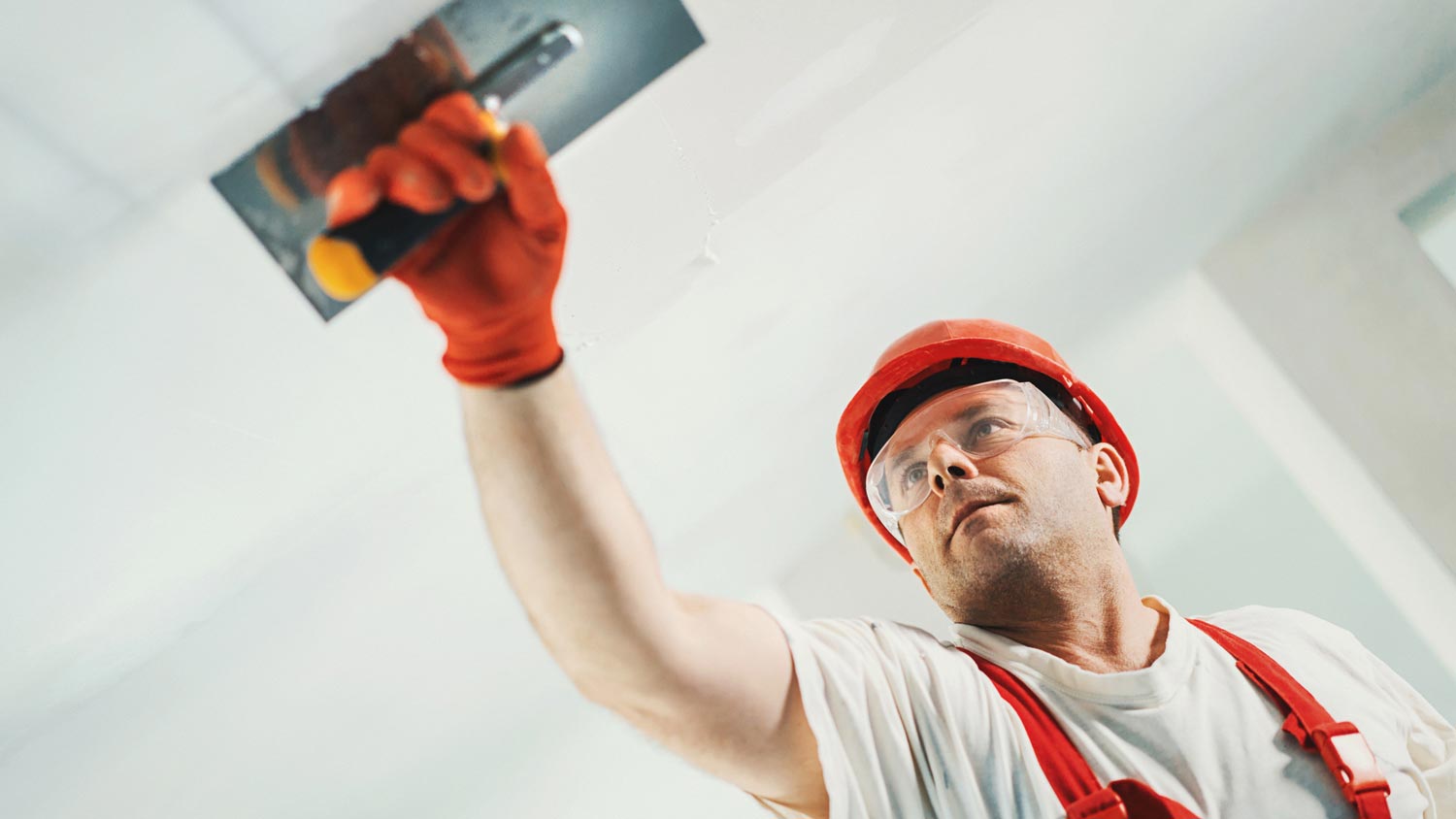
Skim coating drywall is a great alternative to replacement, and is often more affordable. Use this guide to estimate the cost to skim coat walls in your home.
Properly cared-for drywall can last a lifetime


In ideal conditions, drywall can last 40 to 70 years.
Moisture exposure can shorten drywall’s life span.
Drywall is easier to puncture as it ages.
A termite or rodent infestation can damage drywall.
On average, drywall repair costs $600, and replacement costs $2,100.
If you’re purchasing an older home, you may have a few concerns about major parts of the home, like the condition of the roof and foundation. But don’t forget to assess the condition of the drywall, too. In a situation like this, it’s natural to wonder, how long does drywall last? Luckily, drywall can last 40 to 70 years in ideal conditions. The following signs indicate that your drywall may be nearing the end of its useful life and can give you some useful information before sealing the deal.
Unfortunately, there’s no easy way to tell when a drywall installation occurred in an older home unless the previous homeowner has dated receipts or photos to share with you. The use of drywall in home construction became common during the housing boom in the United States after World War II.
If your home was built after the mid-1940s, it may have original drywall. However, it’s also possible that an earlier owner replaced the drywall during a remodeling job in the past few decades. Even in a home built before World War II, a prior homeowner may have replaced a plaster wall with drywall during a remodeling project.
It’s more important to examine the current condition of the drywall to determine whether it’s nearing the end of its useful life span. A drywall contractor can inspect your walls and suggest the best options for extending the life of the drywall or replacing what you have.

Drywall may not last as long as expected in areas with high moisture levels, like a bathroom. Repeated moisture exposure can soften and weaken the drywall material. You may notice that you can put holes in the drywall by simply hitting it with a doorknob or pushing on it. Consider using moisture- and mold-resistant drywall during new drywall installation or replacement in these areas.
Beyond accumulating moisture damage over time, flooding can damage drywall quickly, as the material may soak up the standing water. Roof leaks can also lead to problems with constantly damp drywall in your walls and ceilings.
Eventually, you could experience mold growth if you leave the wet drywall in place, significantly shortening its life span.
When holes and cracks in drywall aren’t repaired, moisture can penetrate the material and accumulate. Holes and other types of damage penetrate the paper covering on the sheet of drywall, negating a key layer of protection.
Repair any cracks in drywall seams and replace loose drywall tape as soon as possible to prevent moisture penetration.
In addition to diligently fixing damage in drywall, keeping it painted can extend its life span. Paint provides another layer of protection against moisture.
If your drywall gets splashed with liquid or food or your pet keeps making a mess, wipe it up quickly. Don’t put off cleaning messes like this, or you may shorten your drywall’s life span.
Termite damage can affect the integrity of your home’s wood frame, but these destructive insects also eat paper. When they eat the paper covering on drywall, it harms the integrity of the wall covering.
Drooping drywall and tiny pinholes are signs of termite damage. Before repairing or replacing your drywall, find a professional to do a termite inspection and remedy the infestation.
If you end up with an infestation of mice or rats inside your home’s walls, they can also damage your drywall. If a rodent sees light through a crack or hole in your drywall, they will often bore out this hole and make it wide enough to give them an entry and exit path. This also creates a spot for moisture to enter and affect the drywall.
Urine and food that rodents bring inside the walls can damage your drywall from the inside as well. Before attempting to repair or replace any damage to the drywall from rats or mice, contact a rodent exterminator to handle the problem.

Minor damage, like tiny cracks and dents in drywall, requires repairs rather than replacement. For the average homeowner, drywall repair costs $600, but a large job can cost up to $2,000. For the smallest fixes, you can use a DIY drywall repair kit from your local hardware store.
If your drywall is too damaged or not cost-effective to repair, you’ll need to replace it. The average cost to install drywall for a replacement job is about $2,100, although you could pay as much as $6,500 for a large job. Look out for the following signs that it’s time to replace your drywall:
Large holes: These are particularly problematic if several holes or big holes go all the way through the drywall.
Large cracks: Large cracks can be a tell-tale sign of a more significant issue, so call a pro to assess the situation.
Water damage: Water damage fosters mold growth and leaves unsightly stains and discoloration behind. It can also make drywall soft and spongy.
Nail pops: Multiple nail pops in a single area indicate an improper installation. You may need a pro to replace the drywall and install it correctly.
Sagging or warping drywall: Drywall can sag and warp for several reasons, including improper screw placement and water damage. You’ll need to install new drywall to fix the issue.
Damaged texture: If the intricate texture on your drywall is bubbling, flaking, or crumbling, it may be time for a new installation.
Termite or pest damage: Pests like termites and rodents can significantly damage drywall to the point of needing a full replacement.
You may want to contact a professional for advice on repair or replacement. A drywall pro can also estimate how much longer your drywall will last.
To save some money, you could repair or replace your drywall yourself. If you’re wondering how hard it is to hang drywall, you should know this is a challenging DIY project without the right tools and know-how. If you choose to do it yourself, make sure you have another person around to help you.
If you hire a drywall contractor, look for a pro with the necessary experience and credentials. Use Angi’s list of local drywall contractors to find a pro near you.
Bundling services is the best way to save money on drywall installation, repair, and texturing. It’s also more convenient to get everything done by the same team. It’ll save you time, which, when you’re paying labor costs, will also save you money—plus, the results will be more consistent.
From average costs to expert advice, get all the answers you need to get your job done.

Skim coating drywall is a great alternative to replacement, and is often more affordable. Use this guide to estimate the cost to skim coat walls in your home.

Whether you’re trying to keep noise in or out, soundproofing materials are the way to go. Use this guide to see how much it costs to soundproof a room.

Installing beadboard ceilings is a great DIY project. Learn what to expect cost-wise from this project, whether removing or covering a popcorn ceiling.

Drywall is made of a crushed mineral called gypsum sandwiched between two layers of paper. Find out more about the components of drywall in our guide.

Drop ceilings are secondary ceilings of grids or suspended drywall. Learn more about how this ceiling type is used in residential and commercial buildings.

Wet-sanding drywall is a cleaner, safer alternative to dry-sanding. If you’re ready to give it a try, learn how to wet-sand drywall in this step-by-step guide.